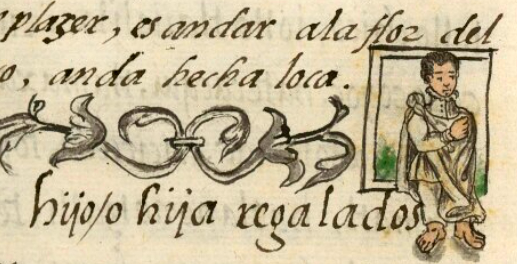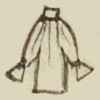oquichpiltontli (FCbk10f2v)
This iconographic example, featuring a noble boy (oquichpiltontli), is included in this digital collection for the purpose of making comparisons with related hieroglyphs and showing European artistic influences. The term selected for this example comes from the text on the same page of the Digital Florentine Codex. There is no gloss, per se. The -tontli suffix added to oquichpilli is reflected in the size of the boy (small). This example shows a frontal view of a young man fully dressed in European trousers and a shirt with a ruffled, high neck. Over all this, he still wears a tilmatli, the cloak of men of noble standing in Nahua society. He does not wear a hat or shoes, which would suggest even more European influence in his manner of dressing.
Stephanie Wood
Interestingly, a few personal names of Nahua men reference some of the new, European clothing items introduced through colonialism. See below.
Stephanie Wood
1577
Jeff Haskett-Wood
niño, muchacho noble, ropa, influencia Europea, influencia española, camisas, tilmas
oquichpilli, a boy, https://nahuatl.wired-humanities.org/content/oquichpilli
el joven noble
Stephanie Wood
Available at Digital Florentine Codex/Códice Florentino Digital, edited by Kim N. Richter and Alicia Maria Houtrouw, "Book 10: The People", fol. 2v, Getty Research Institute, 2023. https://florentinecodex.getty.edu/en/book/10/folio/2v/images/0 Accessed 1 September 2025.
Images of the digitized Florentine Codex are made available under the following Creative Commons license: CC BY-NC-ND (Attribution-NonCommercial-NoDerivs 4.0 International). For print-publication quality photos, please contact the Biblioteca Medicea Laurenziana ([email protected]). The Library of Congress has also published this manuscript, using the images of the World Digital Library copy. “The Library of Congress is unaware of any copyright or other restrictions in the World Digital Library Collection. Absent any such restrictions, these materials are free to use and reuse.”




